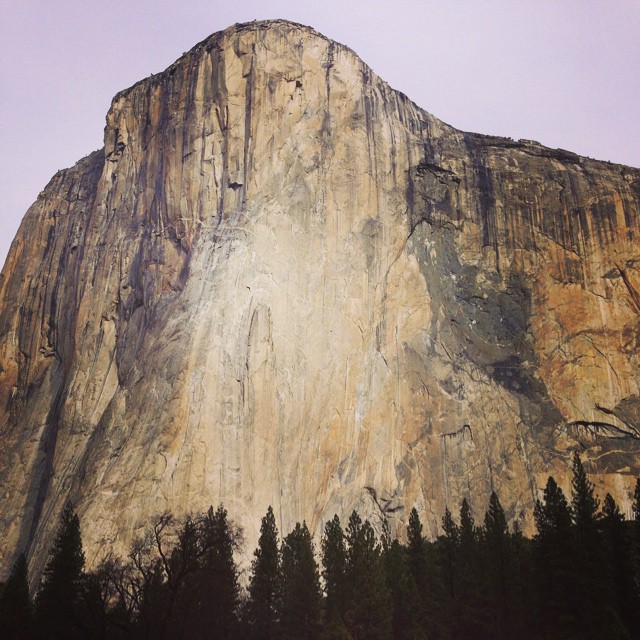“What makes [climbing] the Dawn Wall so special is that it’s almost not possible,” ~Alex Honnold, free solo climber
Something curious happened last week. Rock climbing, a sport not ordinarily defined by the attention of the mainstream, found (or rather, climbed) its way into the headlines of the Washington Post and the New York Times. Matt Lauer and Savannah Guthrie dedicated a solid 2 minutes and 34 seconds to chatting about the sport on the Today Show. Ellen DeGeneres invited climbers onto set, a departure from her usual fare of celebrity interviewees. Barack Obama even tweeted a picture of himself raising a thumbs up to the sport.
So what occurred in the climbing world last week to elicit such a glowing, unabashed display of enthusiasm from the president? How did the sport fundamentally transform its media presence in the space of such a small period of time? The answer can be found on the face of Yosemite’s Dawn Wall, a portion of the behemoth El Capitan. On the evening of January 14th, climbers Tommy Caldwell and Kevin Jorgeson completed their climb of what is widely considered to be the hardest ascent in the world.
This isn’t actually the first time the Dawn Wall has been summited. In fact, in 1970 Warren Harding and Dean Caldwell (unrelated to Tommy) completed the climb over the course of 27 days. One of the primary factors that distinguishes Caldwell and Jorgeson from these inaugural climbers, however, is the climbing technique they used. The 1970 ascent was assisted by ropes, rivets, and bolts; Tommy Caldwell and Kevin Jorgeson, however, supported the entirety of their body weight with their own hands and feet. Equipment was present only to catch the duo if they fell. Hence, theirs was the first free climb of the Dawn Wall ever completed.
The completion of the 32 pitches, or sections, of the route in this manner is truly astounding. The face of the Dawn Wall is, for the most part impossibly smooth. It consists of 3,000 feet of granite textured with intermittent patches of razor-like, spiny texture–the kind destined to rip up hands. Certain pitches of the climb require sideways jumps, difficult maneuvers even when one has equipment to assist himself. And yet, despite the more challenging climbing technique they employed, Caldwell and Jorgeson shaved 8 days off of the original 27 it took to complete the route in 1970.
The vision of climbing the Dawn Wall began in 2008, when Caldwell first began pondering whether or not the route could be free climbed in one full push–that being without returning to the valley floor. Upon hearing about Caldwell’s aspirations, Jorgeson phoned the climber, inquiring if he was interested in having a partner for the expedition. In the years since this call, Caldwell and Jorgeson invested countless hours training for the physical challenge of the climb. They scouted and scoured the wall, mapping the route down to the most minute details. They also waited; the duo watched weather forecasts patiently until a clear stretch appeared on the horizon. That stretch happened to appear in mid December of this past year. On December 27th, Caldwell and Jorgeson began their trying journey.
The pair set up base camp, a collection of tents suspended from the face of the wall. In the evenings, when the wall was coolest–and therefore easiest to grip, the climbers would set out. Once hands were ripped and raw, and morale was in need of a boost, the climbers would belay back down to base camp for needed rest and recovery. This process of scaling the face of the Dawn Wall up and down lasted for 19 days. Some were spent stuck on particularly difficult pitches; Jorgeson fell behind Caldwell as he struggled for some time to complete pitches 14 and 15. Other days brought triumph and progress. Ultimately, the greatest of these triumphant days came on January 14th, when Caldwell and Jorgeson completed the entirety of the route, greeted by friends, family, and champagne at the top of El Capitan.
The journey was remarkable, to be sure. Almost just as remarkable to me, however, was the level of investment the broader world put into this expedition. And when I say “broader world,” I don’t refer simply to the fiercely passionate climber communities scattered across the globe. I mean the common, never-put-hands-on-a-rock-wall demographic. I mean my mother, who sent me daily updates on the status of Jorgeson’s struggles with pitch 15. I mean my roommates and myself–climbers of the most amateur, recreational, beginner sort. After class in the evenings, we would huddle together on the couch in our Henle, checking up on the latest NY Times photo stories from Yosemite. The ascent of the Dawn Wall reached an audience far wider than the climbing community ordinarily sees.
Why, though? Sure, it’s obvious that the completion of the expedition represents an extraordinary act of physical human achievement. But I’m inclined to think there’s something more to all of this, to the admiration and wonder this story has inspired in so many. Climbing, and especially on this scale of difficulty and near unattainability, represents a way of approaching each day that is imbued with a simplicity, passion, and purpose that seems to exist almost nowhere else in this world. And least of all in the hectic daily lives of most Georgetown students.
Over the course of Caldwell and Jorgeson’s 19 day project, I found myself marveling at how utterly simple what they were doing was. Perhaps I should rephrase that. The task at hand wasn’t necessarily uncomplicated. Belying the climbers’ project were years of training, investments of money, and time spent away from family. The day to day of the climb pivoted on a plethora of factors ranging from health, to weather, to morale, and the entirety of the project was being scrutinized by thousands and thousands of people all around the globe. Perhaps it wasn’t what one might traditionally define as simple… But at the end of the day, the factors at play were the men and the rock face. The goal was simply to climb to the top. There’s something intensely and intoxicatingly appealing about an expedition like that, and particularly when it’s set in one of the most beautiful and serene places on the face of the earth. Perhaps I, and the majority of the others who followed Caldwell and Jorgeson’s story, don’t actually yearn to climb the face of El Capitan. Perhaps what wrapped us up in the story was that it reminded us of how sacred simplicity is in a world that’s so often pulling us in a million different directions.
Photos: semi-rad.com, wikimedia.org, newyorktimes.com, nationalgeographic.com, adventurejournal.com





